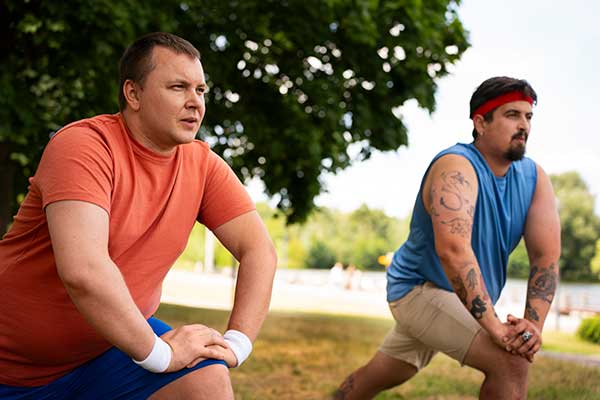Best Stretches for Lower Back Pain
Introduction to Lower Back Pain
Lower back pain is a common issue that many people experience at some point in their lives. Whether it’s due to long hours spent sitting at a desk, lifting heavy objects incorrectly, or simply the wear and tear of daily activities, this discomfort can be frustrating and debilitating. It often limits our ability to enjoy life fully.
The good news? Relief may be just a stretch away. Incorporating targeted stretches into your routine can help alleviate tension and improve flexibility in the lower back region. In this post, we’ll explore some of the best stretches for lower back pain—along with their benefits—and give you tips on how to do them safely. Say goodbye to stiffness and hello to greater mobility!
Causes of Lower Back Pain
Lower back pain can stem from a variety of causes, often making it difficult to pinpoint the exact issue. Common culprits include muscle strains and sprains, which may occur during heavy lifting or sudden movements.
Poor posture is another significant factor. Sitting for prolonged periods with improper alignment can place undue stress on the lower back muscles and spine.
Injuries from sports or accidents are also frequent sources of discomfort. Whiplash or falls can lead to lasting effects that manifest as chronic pain.
Health conditions such as arthritis or herniated discs contribute as well. These issues affect spinal structures and nerve function, leading to ongoing discomfort.
Lifestyle choices play a role too. Lack of exercise weakens core muscles while excess weight adds strain on the lower back, exacerbating existing problems.
Benefits of Stretching for Lower Back Pain
Stretching offers significant relief for those dealing with lower back pain. It helps increase flexibility in the muscles and joints, allowing for better movement. This can reduce tension and discomfort in the lower back area.
Regular stretching promotes blood flow to tight muscles, which aids healing. Increased circulation delivers essential nutrients that help repair damaged tissues over time.
Moreover, engaging in stretches can improve posture by encouraging proper alignment of the spine. Good posture takes pressure off your back, leading to reduced strain during daily activities.
In addition to physical benefits, stretching also has mental advantages. Taking a few moments to stretch provides an opportunity for relaxation and stress reduction. A calmer mind contributes positively to how one perceives pain.
Implementing a consistent stretching routine may prevent future episodes of lower back pain as well. With regular practice, you’ll likely notice improved mobility and overall comfort throughout your day-to-day life.
Top 5 Stretches for Lower Back Pain
Child’s Pose is a gentle stretch that helps relax the back. Kneel on the floor, sit back on your heels, and extend your arms forward. This pose promotes deep breathing while releasing tension.
Next up is the Cat-Cow Stretch. Start on all fours and alternate between arching your back towards the ceiling and dipping it down while lifting your head. This dynamic movement increases flexibility in both directions.
The Standing Hamstring Stretch targets tight hamstrings that can stress lower back muscles. Stand tall, reach for your toes while keeping knees slightly bent, then hold to feel a satisfying stretch along the back of your legs.
Sphinx Pose offers a deeper stretch for the spine. Lie face down with elbows under shoulders and lift your chest gently off the ground; this encourages spinal extension without straining.
Try Figure 4 Stretch to target hip tightness affecting lower back pain. Lie on your back, cross one ankle over the opposite knee, then pull that leg toward you for relief in both hips and lower back areas.
A. Child’s Pose
Child’s Pose is a gentle stretch that works wonders for lower back pain. It invites relaxation and promotes flexibility, making it a favorite among yoga enthusiasts.
To perform this pose, kneel on the floor with your big toes touching and knees apart. Sit back on your heels and extend your arms forward, resting your forehead on the ground. This position creates a calming effect while elongating the spine.
As you breathe deeply, feel the tension in your lower back slowly dissipate. The stretch opens up the hips and relieves pressure along the vertebrae.
It’s an ideal move to integrate into any routine—whether you’re looking to unwind after a long day or warm up before more intense stretches. Child’s Pose can be held for several breaths or longer if it feels comfortable, providing ample time to connect with your body and mind.
B. Cat-Cow Stretch
The Cat-Cow Stretch is a dynamic yoga posture that brings flexibility and relief to the spine. This gentle movement alternates between arching and rounding your back, promoting mobility in the lower back area.
Start on all fours with your wrists aligned beneath your shoulders and knees under your hips. As you inhale, drop your belly toward the mat while lifting your head and tailbone towards the sky—this is Cow Pose.
On exhaling, round your back upwards like an angry cat, tucking in your chin and pelvis. The fluid transition helps release tension accumulated throughout the day.
Aim for five to ten cycles of breaths as you move through these positions. You’ll find that not only does it stretch out tight muscles, but it also encourages relaxation within both body and mind. It’s perfect whether you’re starting or ending a workout routine!
C. Standing Hamstring Stretch
The Standing Hamstring Stretch is an effective way to alleviate tension in your lower back. It targets the hamstrings, which often hold tightness that can contribute to discomfort.
To perform this stretch, begin by standing tall with your feet hip-width apart. Slowly bend at the hips while keeping your knees slightly soft. Reach down toward your toes, feeling a gentle pull along the back of your legs.
Hold this position for about 20-30 seconds. Remember to breathe deeply and relax into the stretch. If you can’t reach your toes yet, that’s perfectly fine—just go as far as you comfortably can.
You may also want to use a chair or wall for support if needed. This provides stability and allows you to focus on getting the most out of the stretch without straining yourself too much. Regular practice can lead to increased flexibility and reduced pain over time.
D. Sphinx Pose
The Sphinx Pose is a gentle yet effective stretch perfect for relieving lower back pain. It encourages spinal extension and opens up the chest, providing a soothing sensation throughout your back.
To perform this pose, lie on your stomach with your legs extended behind you. Place your elbows under your shoulders and press into the ground gently. Keep your forearms parallel to each other while lifting your chest off the mat.
As you engage in this posture, breathe deeply. Feel the stretch along your spine as you lengthen through the crown of your head. Hold this position for 15 to 30 seconds while relaxing any tension in the neck or shoulders.
This pose not only stretches key muscles but also promotes better posture by strengthening the lower back. Incorporate it into daily routines for immediate relief from discomfort and tension in that area.
E. Figure 4 Stretch
The Figure 4 Stretch is a fantastic way to target your lower back and glutes. It helps relieve tension in these areas, promoting overall relaxation.
To begin, lie on your back with your knees bent. Place one ankle over the opposite knee, forming a figure 4 shape. Gently pull the bottom leg towards you while keeping your head and shoulders relaxed on the ground.
Feel the stretch in your hip and lower back as you hold this position for about 30 seconds. Switch sides to ensure both hips receive equal attention.
This stretch not only alleviates tightness but also improves flexibility. Incorporating it into your routine can lead to long-lasting relief from discomfort associated with lower back pain.
Tips for Properly Stretching the Lower Back
Proper stretching is essential for relieving lower back pain effectively. Start slow and listen to your body. If a stretch feels uncomfortable, ease up.
Warm-up before you begin. A few minutes of light activity helps prepare the muscles, making them more pliable and less prone to injury.
Breath control matters. Inhale deeply through your nose as you enter each stretch, then exhale slowly while holding it. This promotes relaxation and enhances the effectiveness of the stretch.
Focus on form rather than depth. It’s better to perform a shallow stretch correctly than to push too far with poor technique.
Hold each position for at least 20-30 seconds but avoid bouncing or jerking movements; these can lead to strain.
Incorporate stretches into your daily routine for best results over time, allowing your muscles to adapt and strengthen naturally without risk of overexertion or injury.
When to Seek Medical Attention
Knowing when to seek medical attention for lower back pain is crucial. If your discomfort persists beyond a few weeks, it’s time to consult a healthcare professional.
Watch for symptoms that accompany the pain, such as numbness or weakness in your legs. These could indicate nerve issues requiring immediate evaluation.
If you experience severe pain after an injury or fall, don’t hesitate to reach out for help. It’s better to be safe than sorry.
Fever or unexplained weight loss alongside back pain can also signal serious conditions like infections or tumors. Prompt medical advice is essential in these scenarios.
If everyday activities become challenging due to your back pain, consider discussing it with your doctor. They may offer solutions tailored specifically for you and provide peace of mind regarding your health journey.
Conclusion
Living with lower back pain can be incredibly challenging. Finding relief through stretching is a natural and effective approach that many people overlook. The best stretches for lower back pain not only alleviate discomfort but also promote flexibility and strength in your muscles.
Incorporating these five stretches into your routine can make a significant difference in how you feel daily. Remember, consistency is key when it comes to reaping the benefits of stretching. Listen to your body and adjust as needed.
If you’re ever unsure about what movements are right for you or if the pain persists, seeking medical attention is important. Your health should always come first.
Embrace the journey toward better mobility by making stretching a regular part of your life. Before long, you’ll likely notice improvements in both comfort and function as you tackle each day with less strain on your back.
- About the Author
- Latest Posts
Johnnie D. Jackow Sr., the founder and CEO of Total Body Fitness, Worldwide, has a long-standing career in the fitness industry. He began as a certified personal trainer in the mid-90s and soon after authored his first weight loss book in 1998. This led to the launch of Total Body Fitness, Nationwide in the USA at the same time. Johnnie gained recognition as the fitness guru of his time, running infomercials on local TV late at night in Houston, Texas. Over the years, he has helped more than 40,000 individuals from all over the world achieve their health and fitness goals. With over 60,000 hours of documented training in integrative functional medicine, he completed his PhD in human physiology in 2010. His primary objective is to assist people in reaching their health and fitness goals through alternative approaches rather than relying solely on conventional medicine and pharmaceutical drugs. Today, with almost three decades of experience under his belt, Johnnie continues to be a leader in health and fitness.








